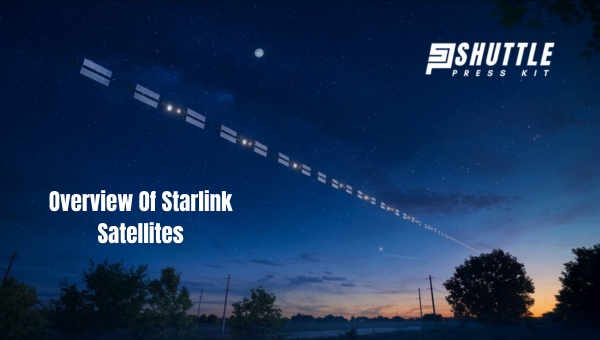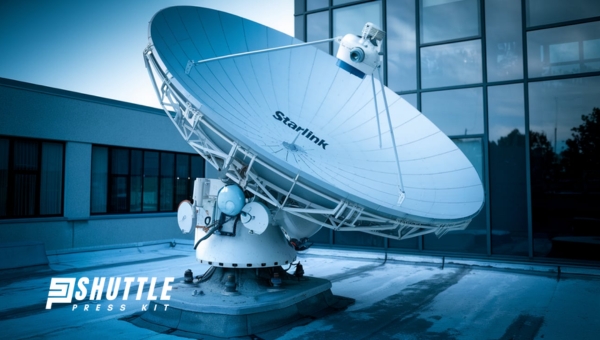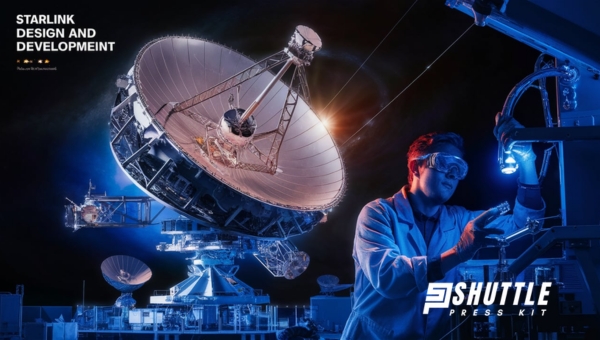Wondering how big is a Starlink satellite and what makes it so special? You’re in the right place! In this article, we’ll delve into the fascinating world of Starlink satellites, from their size and specifications to their design evolution and impact on astronomy.
Plus, we’ll explore their operational aspects and future prospects. By the end, you’ll have a comprehensive understanding of these groundbreaking satellites and their role in shaping global connectivity. Let’s dive in!
| Specification | First-Generation Satellites | Second-Generation Satellites |
|---|---|---|
| Size | 2.4 meters (7.9 feet) in length, 1.1 meters (3.6 feet) in width | 3 meters (9.8 feet) in length, 1.5 meters (4.9 feet) in width |
| Weight | 260 kilograms (573 pounds) | 300 kilograms (661 pounds) |
| Solar Arrays | 4.5 meters (14.8 feet) when deployed | 6 meters (19.7 feet) when deployed, redesigned for greater efficiency |
| Communication Technology | Phased array antennas for ground communication | Upgraded phased array antennas with advanced laser communication systems for inter-satellite links |
| Altitude | 340 km to 550 km (211 to 342 miles) in low Earth orbit | 340 km (211 miles), designed for reduced latency and improved signal quality |
Overview Of Starlink Satellites
Starlink satellites are part of an ambitious project by SpaceX to provide global internet coverage. The primary goal is to create a network of small satellites that deliver high-speed internet access, especially in remote and underserved areas.

By forming a constellation of thousands of satellites, Starlink aims to offer reliable and fast internet service worldwide.
This initiative promises to revolutionize how we connect to the internet, bridging the digital divide and enhancing communication globally.
Size And Specifications
Understanding the size and specifications of Starlink satellites is crucial to grasping their impact and functionality.

Starlink satellites have undergone significant advancements from their first generation to their second generation, enhancing their performance and capabilities.
First-Generation Satellites
The first-generation Starlink satellites are quite remarkable in design and functionality. Here’s a breakdown of their size and specifications:
- Size: These satellites measure 2.4 meters (7.9 feet) in length and 1.1 meters (3.6 feet) in width, making them compact yet efficient devices.
- Weight: Each satellite weighs around 260 kilograms (573 pounds), allowing for easier launches and positioning in space.
- Solar Arrays: When deployed, the solar arrays extend up to 4.5 meters (14.8 feet), providing the necessary power for the satellite to operate.
- Communication Technology: Equipped with phased array antennas, these satellites facilitate ground communication effectively.
- Altitude: They orbit at altitudes ranging from 340 km to 550 km (211 to 342 miles) in low Earth orbit, achieving optimal performance.
Second-Generation Satellites
The second-generation Starlink satellites have seen notable improvements in both size and functionality. Here’s a detailed look at what makes them stand out:
- Size: These satellites are slightly larger, measuring 3 meters (9.8 feet) in length and 1.5 meters (4.9 feet) in width, allowing for enhanced capabilities.
- Weight: With a weight of about 300 kilograms (661 pounds), these satellites are designed for improved stability and performance in orbit.
- Solar Arrays: The solar arrays are redesigned and, when deployed, reach up to 6 meters (19.7 feet), offering greater efficiency in energy harnessing.
- Communication Technology: Upgraded phased array antennas, along with advanced laser communication systems for inter-satellite links, enhance their communication potential.
- Altitude: These satellites operate at an altitude of 340 km (211 miles), specifically designed to reduce latency and improve signal quality.
The enhancements in the second-generation satellites signify a leap forward in technology, reflecting SpaceX’s commitment to providing reliable and efficient satellite internet services globally.
Also Read: Starlink Satellite Dish: Unleashing Next-Gen Internet Connectivity
Design And Development
Designing and developing Starlink satellites has been an exciting journey. Each generation has seen improvements that make the satellites more efficient and capable.

Let’s dive into how the design has evolved and what key features set them apart.
Design Evolution
The design of Starlink satellites has changed significantly over time. Initially, the first-generation satellites were relatively compact.
They measured 2.4 meters in length and 1.1 meters in width. These early models were equipped with phased array antennas, which allowed for effective ground communication.
As technology progressed, the second-generation satellites came into play. These newer models are larger, extending to 3 meters in length and 1.5 meters in width.
This increase in size provides more space for advanced features. They also include upgraded phased array antennas and laser communication systems for better inter-satellite links.
The design changes ensure that the satellites offer reduced latency and improved signal quality.
Key Features
Starlink satellites boast several key features that make them stand out. One of the most notable is their phased array antennas. These antennas enable efficient ground communication, ensuring reliable internet connectivity.
The second-generation satellites have further enhancements. They feature advanced laser communication systems that facilitate better inter-satellite links. Another critical feature is their solar arrays.
The first-generation satellites have solar arrays that extend to 4.5 meters when deployed. In contrast, the second-generation models have larger and more efficient solar arrays, measuring up to 6 meters when deployed.
These features contribute to the overall performance and reliability of the Starlink network, making it a robust option for global internet coverage.
Also Read: Starlink Stock: Discover the Next Big Investment Opportunity!
Operational Aspects
Understanding the operational aspects of Starlink satellites is crucial for grasping their functionality and impact. Let’s dive into how these satellites are placed in orbit and their lifespan.
Placement In Orbit
Starlink satellites are strategically placed in low Earth orbit (LEO), ranging between 340 km to 550 km above the Earth’s surface.
This specific altitude is chosen to reduce latency and enhance signal quality for internet services. Once launched, the satellites use onboard propulsion systems to reach their designated positions.
This carefully planned deployment ensures optimal coverage and reliability for users across the globe.
Lifespan And Deorbiting
The operational lifespan of a Starlink satellite is designed to be around five to seven years. During this period, the satellites provide uninterrupted service, thanks to their robust design and advanced technology.
When a satellite reaches the end of its life cycle, it is guided to a lower orbit to begin the deorbiting process. This controlled descent ensures that the satellite re-enters the Earth’s atmosphere safely, where it burns up completely, minimizing space debris.
This approach not only extends the life of the satellite network but also maintains a sustainable orbital environment.
Also Read: How to Set Up Wi-Fi on Satellite Internet: Easy Steps!
Impact On Astronomy
The rise of Starlink satellites has brought attention to their impact on astronomy. These satellites significantly affect astronomical observations, particularly through optical interference and collision risks.
Let’s delve into these aspects to understand their implications better.
Optical Interference
Starlink satellites, with their reflective surfaces, can pose challenges for astronomers:
- Brightness of Satellites: These satellites reflect sunlight, creating bright streaks across the night sky. This can interfere with the clarity of astronomical images.
- Data Contamination: The presence of Starlink satellites can introduce noise into the data collected by telescopes. This makes it harder for astronomers to analyze celestial objects accurately.
- Impact on Surveys: Large-scale sky surveys may be compromised. Satellites can obscure or mimic the signals of distant astronomical phenomena, hindering the discovery of new celestial bodies.
Collision Risks
The sheer number of Starlink satellites in orbit brings about collision risks:
- Space Debris: More satellites mean a higher risk of collisions with other space objects. This contributes to the growing issue of space debris.
- Operational Challenges: Satellite operators must constantly monitor and adjust orbits to avoid potential collisions. This process can divert resources and attention from scientific research.
- Long-term Sustainability: The risk of collisions raises concerns about the future sustainability of space operations. It could affect future astronomical missions and the deployment of new satellites.
Understanding these impacts is crucial for balancing technological advancement with the preservation of astronomical research.
Also Read: Starlink Price Revealed: Affordable Internet for Everyone!
Future Prospects
The future looks bright for the Starlink satellite network. Exciting expansion plans are on the horizon, promising to revolutionize global internet connectivity.
From rural areas to bustling cities, Starlink aims to make high-speed internet accessible to everyone. Let’s dive into their ambitious plans for the future.
Expansion Plans
Starlink has a roadmap filled with promising ventures:
- Global Coverage: The primary goal is to achieve near-global coverage by launching thousands of additional satellites. This will ensure even the most remote corners of the world can access high-speed internet.
- Technological Enhancements: Starlink is investing heavily in advanced technologies. These enhancements include better beamforming and increased bandwidth capabilities, which will significantly improve performance and user experience.
- Partnerships and Collaborations: Starlink plans to collaborate with governments and organizations worldwide. These partnerships are crucial for deploying services in underserved regions, making internet access more equitable.
- Regulatory Compliance: To facilitate expansion, Starlink is actively working with regulatory bodies in various countries. Securing necessary approvals for satellite launches and operations is a key part of their strategy.
- User Growth: The network anticipates a significant increase in its user base. The growing demand for remote work, online education, and digital services, particularly in areas lacking traditional infrastructure, will drive this growth.
The future of Starlink is not just about more satellites; it’s about better connectivity, improved technology, and greater accessibility for everyone.
Conclusion
Starlink satellites have revolutionized global internet connectivity with their innovative design and advanced technology. From the first-generation to the more sophisticated second-generation models, they have shown significant progress.
Their impact on astronomy and their strategic placement in orbit highlight both their benefits and challenges. As SpaceX continues to expand the Starlink network, the future looks promising for even faster and more reliable internet access worldwide.
If you found this article informative, be sure to explore more engaging content on our site. Don’t miss out on the latest updates and insights!
